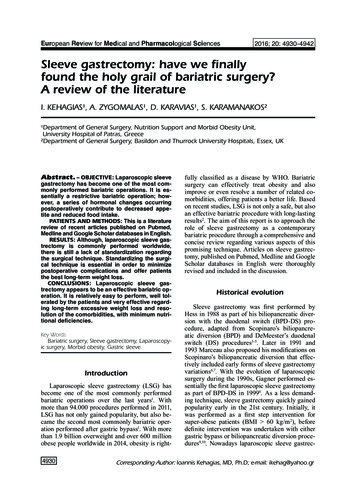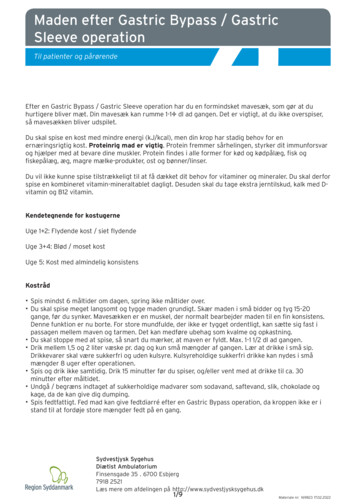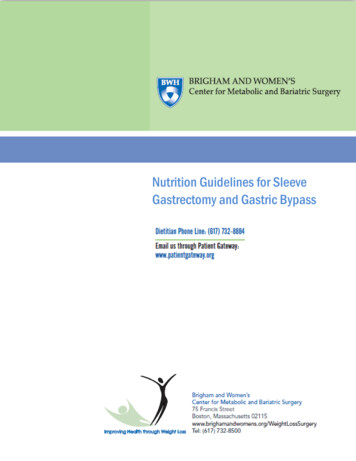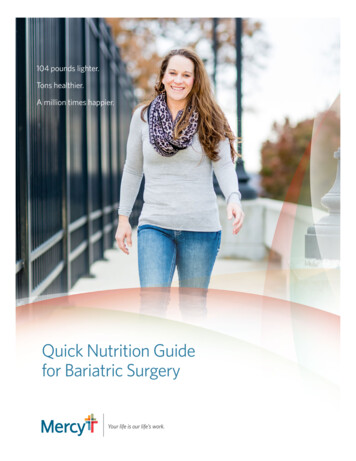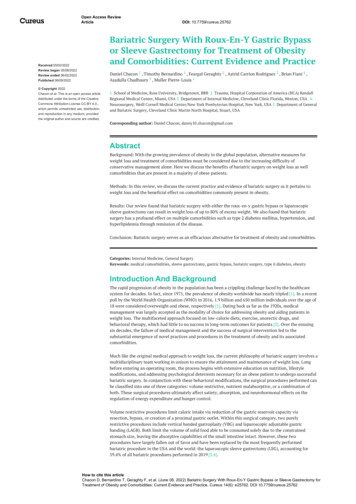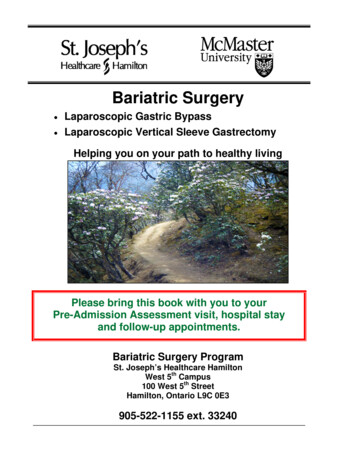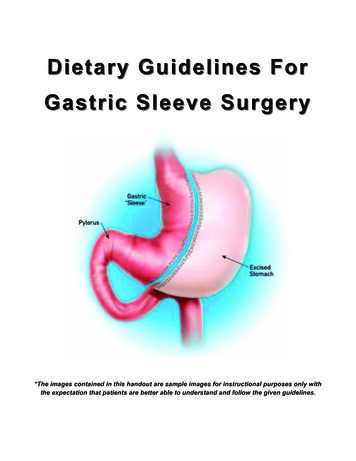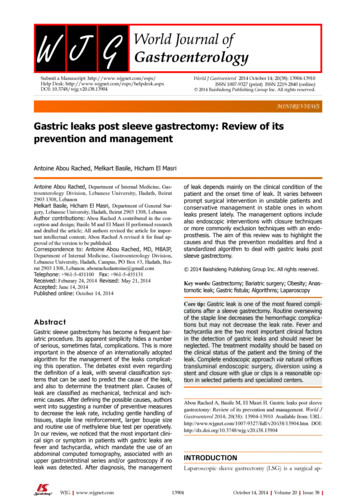
Transcription
World J Gastroenterol 2014 October 14; 20(38): 13904-13910ISSN 1007-9327 (print) ISSN 2219-2840 (online)Submit a Manuscript: http://www.wjgnet.com/esps/Help Desk: http://www.wjgnet.com/esps/helpdesk.aspxDOI: 10.3748/wjg.v20.i38.13904 2014 Baishideng Publishing Group Inc. All rights reserved.MINIREVIEWSGastric leaks post sleeve gastrectomy: Review of itsprevention and managementAntoine Abou Rached, Melkart Basile, Hicham El MasriAntoine Abou Rached, Department of Internal Medicine, Gastroenterology Division, Lebanese University, Hadath, Beirut2903 1308, LebanonMelkart Basile, Hicham El Masri, Department of General Surgery, Lebanese University, Hadath, Beirut 2903 1308, LebanonAuthor contributions: Abou Rached A contributed in the conception and design; Basile M and El Masri H performed researchand drafted the article; All authors revised the article for important intellectual content; Abou Rached A revised it for final approval of the version to be published.Correspondence to: Antoine Abou Rached, MD, MBAIP,Department of Internal Medicine, Gastroenterology Division,Lebanese University, Hadath, Campus, PO Box #3, Hadath, Beirut 2903 1308, Lebanon. abourachedantoine@gmail.comTelephone: 961-5-451100 Fax: 961-5-455131Received: Feburary 24, 2014 Revised: May 21, 2014Accepted: June 14, 2014Published online: October 14, 2014AbstractGastric sleeve gastrectomy has become a frequent bariatric procedure. Its apparent simplicity hides a numberof serious, sometimes fatal, complications. This is moreimportant in the absence of an internationally adoptedalgorithm for the management of the leaks complicating this operation. The debates exist even regardingthe definition of a leak, with several classification systems that can be used to predict the cause of the leak,and also to determine the treatment plan. Causes ofleak are classified as mechanical, technical and ischemic causes. After defining the possible causes, authorswent into suggesting a number of preventive measuresto decrease the leak rate, including gentle handling oftissues, staple line reinforcement, larger bougie sizeand routine use of methylene blue test per operatively.In our review, we noticed that the most important clinical sign or symptom in patients with gastric leaks arefever and tachycardia, which mandate the use of anabdominal computed tomography, associated with anupper gastrointrstinal series and/or gastroscopy if noleak was detected. After diagnosis, the managementWJG www.wjgnet.comof leak depends mainly on the clinical condition of thepatient and the onset time of leak. It varies betweenprompt surgical intervention in unstable patients andconservative management in stable ones in whomleaks present lately. The management options includealso endoscopic interventions with closure techniquesor more commonly exclusion techniques with an endoprosthesis. The aim of this review was to highlight thecauses and thus the prevention modalities and find astandardized algorithm to deal with gastric leaks postsleeve gastrectomy. 2014 Baishideng Publishing Group Inc. All rights reserved.Key words: Gastrectomy; Bariatric surgery; Obesity; Anastomotic leak; Gastric fistula; Algorithms; LaparoscopyCore tip: Gastric leak is one of the most feared complications after a sleeve gastrectomy. Routine oversewingof the staple line decreases the hemorrhagic complications but may not decrease the leak rate. Fever andtachycardia are the two most important clinical factorsin the detection of gastric leaks and should never beneglected. The treatment modality should be based onthe clinical status of the patient and the timing of theleak. Complete endoscopic approach via natural orificestransluminal endoscopic surgery, diversion using astent and closure with glue or clips is a reasonable option in selected patients and specialized centers.Abou Rached A, Basile M, El Masri H. Gastric leaks post sleevegastrectomy: Review of its prevention and management. World JGastroenterol 2014; 20(38): 13904-13910 Available from: 3904.htm RODUCTIONLaparoscopic sleeve gastrectomy (LSG) is a surgical ap-13904October 14, 2014 Volume 20 Issue 38
Abou Rached A et al . Management of leaks post sleeve gastrectomyTable 1 Different leak sites as found by different series n (%)Mui et al[64], 2008Burgos et al[18], 2009Csendes et al[16], 2010Sakran et al[14], 2013Number of patientsProximal third70 patients, 1 leak (1.42)214 patients, 7 leaks (3.3)334 patients, 16 leaks (4.66)2834 patients, 44 leaks (1.5)1 (100)6 (85.6)14 (87.5)33 (75)Mid-thirdDistal thirdPosterior wallNot located3 (6.8)1 (14.3)2 (12.5)3 (6.8)2 (4.5)3 (6.8)proach to treat morbid obesity. It restricts the stomach’ssize to induce satiety and resects fundal ghrelin-producingcells to decrease appetite[1,2].LSG has become a very frequent procedure in bariatric surgery, due to its simplicity and efficacy compared tothe gastric bypass procedure[3,4].The fact that this technique has erroneously beenconsidered simple and easy has led to its adoption by alarge number of surgeons. Compared to gastric bypassand biliopancreatic diversion, its complications can beeven more severe[5]. Staple line leaks, bleeding, and strictures are the commonly reported complications followingLSG. Based on the data of 12799 LSGS, the International Sleeve Gastrectomy Expert Panel Consensus Statement2011, the leak rate was 1.06%[4], but the leak rate can varybetween 1% and 3% for primary procedure[6] and morethan 10% in revision procedures[7-9].rect tissular injury are categorized as “mechanical-tissular”causes and usually appear within 2 d of surgery (early),compared to the “ischemic causes” that usually appear onday 5-6 post operatively (post op) (intermediate).In a multicenter experience with 2834 patients, leakspost LSG included improper vascularization due to anaggressive dissection especially of the posterior attachments of the upper sleeve, thermal injuries to the gastrictube by ultrasonic devices (harmonic, Ligasure), staplerdevices misfiring, stapling of the orogastric tube[14].Patients with distal stenosis are more likely to haveproximal leaks, because of gastric emptying impairmentleading to increased intraluminal pressure and decreasedcompliance of the gastric tube[15,16].Other mechanisms concerning gastric leak post sleeveare still obscure, with a case report that presented 16 moafter surgery[17].DEFINITION OF LEAKPREVENTIONAccording to the United Kingdom Surgical InfectionStudy Group, a gastric leak was defined as “the leak ofluminal contents from a surgical join between two hollow viscera”. It can also be an effluent of gastrointestinalcontent through a suture line, which may collect near theanastomosis, or exit through the wall or the drain[10].Leaks can be classified based either on the time ofonset, clinical presentation, site of leak, radiological appearance, or mixed factors (Table 1).Csendes et al[11] defined early, intermediate and lateleaks as those appearing 1 to 4, 5 to 9 and 10 or more daysfollowing surgery respectively. By clinical relevance andextent of dissemination, they defined type Ⅰ or subclinicalleaks as those that are well localized without dissemination into the pleural or abdominal cavity, nor inducementof systemic clinical manifestations, usually they are easy totreat medically. Type Ⅱ are leaks with dissemination intoabdominal or pleural cavity, or the drains with consequentsevere and systemic clinical manifestations.Based on both clinical and radiological findings, typeA are microperforations without clinical or radiographicevidence of leak, while type B are leaks detected by radiological studies but without any clinical finding, andfinally, type C are leaks presenting with both radiologicaland clinical evidence[12].Some authors advocate gentle handling of tissues whenusing ultrasonic devices and staplers, avoiding distal stenosis[16,18], in addition to sustaining steady compressionon the staple device before firing to washout the fluidsfrom the tissues[13].Does staple line reinforcement or buttressing preventor decrease the leak rate is a question that was addressedin several studies, some of them concluded that reinforcement with oversewing decreases the leakage rate[19],some of these authors were based on retrospective, noncontrolled studies[20], others recommend the use of PSD(Peri Strips Dry, a bovine pericardium with collagen matrix) to decrease the leakage rate[21-23]. Ser et al[24] recommend oversewing despite their admission that their highleakage rate in their first cases (40 cases out of 118) isprobably attributed to the learning curve.Fibrin sealants (Tissucol) were also addressed insome studies with good impact in term of decreasingleakage rate[25,26].Large randomized prospective trials and a recentmeta-analysis showed no significant difference betweenreinforcement (by oversewing or Seamguard) and without reinforcement in term of leakage rate[27,28], other largeseries reported no leakage without any reinforcement[29],most of the others agree that reinforcement decreasesthe complication rate in term of bleeding but not in termof leak[30,31].Based on what we mentioned previously concerning the impact of increased intraluminal pressure on thegastric leak formation[14,16], Márquez et al[5] leave the naso-CAUSESGastric leaks can be due to mechanical or ischemiccauses. According to Baker et al[13] stapler misfiring, or di-WJG www.wjgnet.com13905October 14, 2014 Volume 20 Issue 38
Abou Rached A et al . Management of leaks post sleeve gastrectomyAbdominal painWithout fever and tachycardia Fever tachycardiaCBCD CRPAbdominal CT withwatersoluble PO and Ⅳ Observation and reassessUpper GI gastroscopy Management according to condition of patient Consider clinical status of the patientNo evidence of systemic illnessEvidence of systemic illnessDiagnostic therapeutic laparoscopyObserve and treat medicallyFigure 1 Algorithm for the workup of abdominal pain post sleeve gastrectomy, when a leak is suspected. CBCD: Complete blood count with differential; CRP:C-reactive protein; CT: Computed tomography; PO: Per os; IV: Intravenous; GI: Gastrointestinal.gastric tube in place for 24 h post op to decrease intraluminal pressure.The size of the bougie to be used for calibration isalso a subject of controversies, with bougie size ranging between 32 and 60 fr[32], with the rational that usingsmaller sizes leads to better outcome in term of sustainedexcessive weight loss[33], but on the other hand a largesystematic review taking 4888 patients and another largemeta-analysis of 9991 patients suggest that larger bougiesize may decrease the leak rate, but further randomizedstudies are needed to assure the exact effect of the bougie size on the leak rate[14,16,25].Based on the fact that operative detection of a technically induced staple line defect can be treated withprompt closure, other modalities are adopted by a widenumber of authors and surgeons including the routineuse of methylene blue test during surgery for detectionof leaks, with high sensitivity and specificity[34-36], intraoperative endoscopy or air leak test[37,38]. But we should keepin consideration that a negative intraoperative methyleneblue test does not eliminate the presence of a leak[14,39].The use of closed suction drain routinely near thestaple line, despite that it is performed by the majorityof surgeons, may not detect leak, and may not be helpfulalso in the drainage of the collection[31,32].The cornerstones in the revisional bariatric surgeryinclude clear identification of the existing anatomy necessitating extensive dissection and adhesiolysis, taking inconsideration the stomach wall thickness due to fibrosisor edema, pushing the surgeon to appropriately choosethe size of stapler’s height (usually 4.5 mm), oversewingof the gastric tube at the level of the staple line, leak test,and gastrostomy tube[40].Based on the increased incidence of leakage in therevision surgeries, some authors advocate two steps procedure, gastric band removal followed by the sleeve witha delay between 6 to 12 wk[41,42].WJG www.wjgnet.comDIAGNOSISDebates still exist on which diagnostic modality is themost sensitive and specific concerning the diagnosis ofa post sleeve gastrectomy leakage, but all of them agreethat early detection is associated with better outcome,and that a high index of suspicion is the cornerstone inthe detection and diagnosis of leaks[14,43,44].PRESENTATION AND WORKUPClinical presentation can vary widely between totallyasymptomatic patients diagnosed with routine imagingstudies (upper gastrointrstinal series ) post op[36], thatare considered type A as mentioned previously[12], to thesigns and symptoms of a septic shock including fever,abdominal pain, peritonitis, leucocytosis, tachycardia, hypotension[12] (Figure 1).Unexplained fever and tachycardia post op shouldraise the index of suspicion of a possible complicationand push the surgeon to perform further radiological investigations to R/O the presence of leak[16].As for Csendes et al[16] and Dakwar et al[17], fever is themost important clinical factor in the diagnosis of gastricleak post sleeve gastrectomy.Others agree that tachycardia is the earliest[18], andmost important and constant clinical finding indicatingthe presence of a gastric leak[45], and a tachycardia above120 beat/min is a powerful indicator of leak and systemiccompromise[46].Early leaks usually present with sudden abdominalpain, accompanied with fever and tachycardia in mostcases, while late leaks tend to present with insidious abdominal pain commonly associated with fever[31].Laboratory studies including CBCD, CRP are neithersensitive nor specific, and they rarely contribute to makea diagnosis[14].13906October 14, 2014 Volume 20 Issue 38
Abou Rached A et al . Management of leaks post sleeve gastrectomyManagement according to condition of patientUnstableStablePrompt surgicalintervention:Lavage drainage oversewingPrompt surgical interventionIntermediate and lateEarlyLavage and drainage according tothe skill of the surgeonConservative management:NPO, Ⅳ hydration, PPI, TPN,percutaneous drainage of anycollection, broad spectrumantibiotherapy, weekly upper GI seriesOpenNot improving by radiologicaland clinical measuresImproving by radiologicaland clinical measuresContinue sameconservative managementLaparoscopyEndoscopic trial withendoprosthesisRemoval at 6 to 8 wkSurgical management:Lavage and drainageImproving by radiologicaland clinical measuresNot improving by radiologicaland clinical measuresContinue samemanagementMore radical surgery:Roux-en-Y gastrojejunostomyvs gastrecomyFigure 2 Algorithm for the management of a gastric leak post sleeve gastrectomy. NPO: Nil per os; IV: Intravenous; PPI: Proton pump inhibitor; TPN: Total parenteral nutrition; GI: Gastrointestinal.Computed tomography (CT) of the abdomen withIV and PO water soluble contrast is considered as a partof the diagnostic workup of patients with suspected leak,with the presence of abdominal collection or free fluid,extravasation of contrast into the abdominal cavity or thedrain tube, or persistent pneumoperitoneum as diagnosticfindings of leak or fistula[47].CT is considered to be the best non-invasive modality for detection and confirmation of a gastric leak[16,31,48].These results are also supported in another multicenterexperience showing that CT had the highest detectionrate of gastric leaks in up to 86% of patients[14].This superiority of CT scan over other invasive andnon-invasive modalities is questioned by some investigators, lying on the fact that obesity and large body dimensions [body mass index (BMI) over 50] produce artefactsthat reduce the image quality, added to the technicaldifficulties imposed by the large body weight and dimensions that may overcome the ability of the framework tosupport and thus they recommend upper gastrointestinal(UGI) radiography and endoscopy instead[49].Now concerning the routine performance of the gastrografin swallow test 24-72 h post op, it is still an area oflarge debate. While a large recent retrospective review of712 patient conducted by Wahby et al[36] have shown itsinability to detect post op leakage, they still recommendit to be done routinely, especially that it can detect othercomplications like strictures and anatomical consequences of the sleeve[18,47,50], but at the same time, they recommend to do routine methylene blue test per operatively asmentioned previously.Be aware, knowing that a normal test cannot rule out aWJG www.wjgnet.comfistula, it contrarily can have deleterious effects on the delayof diagnosis when a “normal test” covers a leakage[41,51].Even in the setting of positive diagnosis with CT scanof a leak, an upper gastrointestinal gastrografin swallowis of great importance to identify the magnitude and thelevel of the leak[31].One study mentioned that measuring the amylaselevel in the drain, when in doubt, has a high level of sensitivity and specificity for detecting fistula post gastricbypass surgery, but it was abandoned because it mandatesleaving an unnecessary drain in place for more than 7-10d at least so that an early or intermediate fistula can bediagnosed[52].MANAGEMENTThe management of leak post sleeve gastrectomy imposes a lot of controversies and difficulties in the adoptionof a standard algorithm, due to the paucity of prospective randomized trials that are considered unethical toperform in this situation (Figure 2).Based on the First International Summit for SleeveGastrectomy, the treatment may include early oversewing, drainage (open or laparoscopic), endoscopic clipping,stenting or using fibrin glue, sometimes the use of aRoux limb or total gastrectomy as the last resort[34].The adoption of Csendes et al[16] model of classification for gastric fistula post sleeve may constitute the firststep in the establishment of such an algorithm or protocol, based on 3 characteristics: Time of appearance (early,intermediate and late); Location (proximal, mid or distalgastric); Severity or magnitude (type Ⅰ and Ⅱ).13907October 14, 2014 Volume 20 Issue 38
Abou Rached A et al . Management of leaks post sleeve gastrectomyUnstable patient upon presentation justify promptsurgical intervention by laparoscopic or open means forwashout and drainage at least, that may be coupled withdebridement and suturing of the orifice if the conditionof the patient and the tissues, and the skills and experience of the surgeon permit[18,36].Immediate surgical intervention with washout drainage and suture if the tissue was in an early stage ofinflammation in patients with early leaks showed betteroutcome than the more conservative approach. While theadoption of a more conservative approach for intermediate and late leaks in clinically stable patients is more reasonable with adequate hydration, proton pump inhibitors,nil per os, nutritional support, percutaneous drainage ofany collection and broad spectrum antibiotherapy[16,18,27,36],with a follow up weekly by upper gastrointrstinal seriesto ensure healing, when any concern about healing, moreinvasive approaches may be considered.Most patients who underwent suturing for their fistula failed to close directly due either to persistence of theleak (orifice cannot be identified clearly) or failure of thesuture (inflamed and friable tissue)[13], especially after thethird day post op[16]. For that, a simultaneous endoscopicintervention and insertion of a guide wire (rendez-vous)from the stomach lumen so that the surgeon can identifyclearly the gastric defect to suture it can be used[36].If the leak does not heal after several weeks, usually2 wk, endoscopic management can be considered withwide range of success rate according to the studies[53,54].Endoscopic modalitiesClosure techniques: (1) Endoclips were used initially forhemostasis, later on trials to treat esophageal, colonic andduodenal mucosal defects and perforations were extrapolated to be used in post sleeve gastrectomy leakage[55],now the new over the scope clips (OTSC) have morepromising results, but they are limited for very small mucosal defects and microperforations[56], and are inefficacious in inflammatory or edematous mucosa, demandingtechnical skills; and (2) Sealant materials including fibringlue and cyanoacrylates. Fibrin glue acts by dual effect,as a plug directly occluding the defect and as a fibroblastpromoter to enhance wound healing, thus it is absorbedafter 4 wk and replaced by connective scar tissue[57,58].Exclusion techniques - endoprosthesis (stents):Initially stents were used to treat stenosis, it was shownthat they decrease the intraluminal pressure, which maybe part of the pathophysiology of the gastric leak postsleeve as mentioned above[14], so its use gained a widespread in the management of proximal and middle gastric leak[51] due to the advantage of the ability to resumeper os feeding and discharge the patient home, but themigration index is high, reaching 30%, with the same ratewhen comparing self-expanding metallic stents (SEMS)and self-expanding polyester stents (SEPS)[59].Nguyen et al[54] used self-expanding stents with a success rate of 100%. The gastric sleeve leaks usually takemore than 6 wk to heal (average of 45 d) compared toWJG www.wjgnet.comhealing time in laparoscopic Roux-En-Y gastric bypassleaks (30 d)[16], at the same time keeping the stents forlong periods risks to damage the underlying mucosa, especially with uncovered stents, ideally most authors agreethat 6-8 wk is the optimal removal time, but these prosthesis should be observed closely with the possibility toremove them after 4 wk[14,54,60].A complete endoscopic approach was also suggested by Bège et al[61], without the need for any surgicalintervention that consists of 3 stages of endoscopictreatment: Washout and drainage using natural orificestransluminal endoscopic surgery (NOTES); Diversionusing a stent; Closure with glue or clips.Patients who fail all these measures, need a definitivesurgical intervention with more aggressive and radicaltreatment, including either conversion to gastric bypass,or a Roux-En-Y with a jejunal limb oversewn over thefistula, or finally in some cases a total gastrectomy withesojejunal anastomosis[37,62,63].CONCLUSIONLSG has now gained a wide spread among surgeons; itsapparent simplicity to perform hides a number of tricksand pitfalls to avoid, and a number of general principlesto stick to.The most dreadful complication of this apparentlysimple procedure is gastric leak, which implies a long hospital stay, morbidities and sometime mortalities. Its management is variable, with no standard algorithm to follow,but most of the data demonstrates that the managementshould be planned based on the clinical evaluation, timeof diagnosis and finally the location of the leak.On the other hand and in the absence of a clear approach and guidelines for the management of gastricleaks post sleeve gastrectomy, appears the importanceof prevention, by the simple adherence to general surgical principles, and the particular considerations of sleevegastrectomies.REFERENCES123413908Serra C, Pérez N, Bou R, Bengochea M, Martínez R, BaltasarA. Laparoscopic sleeve gastrectomy. A bariatric procedurewith multiple indications. Cir Esp 2006; 79: 289-292 [PMID:16753118]Marceau P, Cabanac M, Frankham PC, Hould FS, Lebel S,Marceau S, Lescelleur O, Biron S. Accelerated satiation afterduodenal switch. Surg Obes Relat Dis 2005; 1: 408-412 [PMID:16925259]Msika S, Castel B. Present indications for surgical treatmentof morbid obesity: how to choose the best operation? J ViscSurg 2010; 147: e47-e51 [PMID: 20970402 DOI: 10.1016/j.jviscsurg.2010.08.015]Rosenthal RJ, Diaz AA, Arvidsson D, Baker RS, Basso N,Bellanger D, Boza C, El Mourad H, France M, Gagner M,Galvao-Neto M, Higa KD, Himpens J, Hutchinson CM,Jacobs M, Jorgensen JO, Jossart G, Lakdawala M, NguyenNT, Nocca D, Prager G, Pomp A, Ramos AC, Rosenthal RJ,Shah S, Vix M, Wittgrove A, Zundel N. International SleeveGastrectomy Expert Panel Consensus Statement: best practice guidelines based on experience of 12,000 cases. SurgOctober 14, 2014 Volume 20 Issue 38
Abou Rached A et al . Management of leaks post sleeve gastrectomy567891011121314151617181920Obes Relat Dis 2012; 8: 8-19 [PMID: 22248433 DOI: 10.1016/j.soard.2011.10.019]Márquez MF, Ayza MF, Lozano RB, Morales Mdel M, DíezJM, Poujoulet RB. Gastric leak after laparoscopic sleeve gastrectomy. Obes Surg 2010; 20: 1306-1311 [PMID: 20574787DOI: 10.1007/s11695-010-0219-7]Fuks D, Verhaeghe P, Brehant O, Sabbagh C, Dumont F,Riboulot M, Delcenserie R, Regimbeau JM. Results of laparoscopic sleeve gastrectomy: a prospective study in 135 patients with morbid obesity. Surgery 2009; 145: 106-113 [PMID:19081482 DOI: 10.1016/j.surg.2008.07.013]Lacy A, Ibarzabal A, Pando E, Adelsdorfer C, DelitalaA, Corcelles R, Delgado S, Vidal J. Revisional surgeryafter sleeve gastrectomy. Surg Laparosc Endosc PercutanTech 2010; 20: 351-356 [PMID: 20975509 DOI: 10.1097/SLE.0b013e3181f62895]Foletto M, Prevedello L, Bernante P, Luca B, Vettor R, Francini-Pesenti F, Scarda A, Brocadello F, Motter M, Famengo S,Nitti D. Sleeve gastrectomy as revisional procedure for failedgastric banding or gastroplasty. Surg Obes Relat Dis 2010; 6:146-151 [PMID: 19889585 DOI: 10.1016/j.soard.2009.09.003]Iannelli A, Schneck AS, Ragot E, Liagre A, Anduze Y,Msika S, Gugenheim J. Laparoscopic sleeve gastrectomy asrevisional procedure for failed gastric banding and verticalbanded gastroplasty. Obes Surg 2009; 19: 1216-1220 [PMID:19562420 DOI: 10.1007/s11695-009-9903-x]Peel AL, Taylor EW. Proposed definitions for the audit ofpostoperative infection: a discussion paper. Surgical Infection Study Group. Ann R Coll Surg Engl 1991; 73: 385-388[PMID: 1759770]Csendes A, Burdiles P, Burgos AM, Maluenda F, Diaz JC.Conservative management of anastomotic leaks after 557open gastric bypasses. Obes Surg 2005; 15: 1252-1256 [PMID:16259881]Welsch T, von Frankenberg M, Schmidt J, Büchler MW. Diagnosis and definition of anastomotic leakage from the surgeon’s perspective. Chirurg 2011; 82: 48-55 [PMID: 21107971DOI: 10.1007/s00104-010-1916-4]Baker RS, Foote J, Kemmeter P, Brady R, Vroegop T, ServeldM. The science of stapling and leaks. Obes Surg 2004; 14:1290-1298 [PMID: 15603641]Sakran N, Goitein D, Raziel A, Keidar A, Beglaibter N,Grinbaum R, Matter I, Alfici R, Mahajna A, Waksman I, Shimonov M, Assalia A. Gastric leaks after sleeve gastrectomy:a multicenter experience with 2,834 patients. Surg Endosc2013; 27: 240-245 [PMID: 22752283 DOI: 10.1007/s00464-0122426-x]Yehoshua RT, Eidelman LA, Stein M, Fichman S, MazorA, Chen J, Bernstine H, Singer P, Dickman R, Beglaibter N,Shikora SA, Rosenthal RJ, Rubin M. Laparoscopic sleevegastrectomy--volume and pressure assessment. Obes Surg2008; 18: 1083-1088 [PMID: 18535864 DOI: 10.1007/s11695008-9576-x]Csendes A, Braghetto I, León P, Burgos AM. Managementof leaks after laparoscopic sleeve gastrectomy in patientswith obesity. J Gastrointest Surg 2010; 14: 1343-1348 [PMID:20567930 DOI: 10.1007/s11605-010-1249-0]Dakwar A, Assalia A, Khamaysi I, Kluger Y, Mahajna A.Late complication of laparoscopic sleeve gastrectomy. CaseRep Gastrointest Med 2013; 2013: 136153 [PMID: 23662218DOI: 10.1155/2013/136153]Burgos AM, Braghetto I, Csendes A, Maluenda F, KornO, Yarmuch J, Gutierrez L. Gastric leak after laparoscopicsleeve gastrectomy for obesity. Obes Surg 2009; 19: 1672-1677[PMID: 19506979 DOI: 10.1007/s11695-009-9884-9]Baltasar A, Serra C, Pérez N, Bou R, Bengochea M, Ferri L.Laparoscopic sleeve gastrectomy: a multi-purpose bariatricoperation. Obes Surg 2005; 15: 1124-1128 [PMID: 16197783]Angrisani L, Cutolo PP, Buchwald JN, McGlennon TW,Nosso G, Persico F, Capaldo B, Savastano S. Laparoscopic re-WJG nforced sleeve gastrectomy: early results and complications.Obes Surg 2011; 21: 783-793 [PMID: 21494813 DOI: 10.1007/s11695-011-0400-7]Angrisani L, Lorenzo M, Borrelli V, Ciannella M, Bassi UA,Scarano P. The use of bovine pericardial strips on linearstapler to reduce extraluminal bleeding during laparoscopicgastric bypass: prospective randomized clinical trial. ObesSurg 2004; 14: 1198-1202 [PMID: 15527634]Himpens J, Dobbeleir J, Peeters G. Long-term results of laparoscopic sleeve gastrectomy for obesity. Ann Surg 2010; 252:319-324 [PMID: 20622654 DOI: 10.1097/SLA.0b013e3181e90b31]Daskalakis M, Berdan Y, Theodoridou S, Weigand G, Weiner RA. Impact of surgeon experience and buttress materialon postoperative complications after laparoscopic sleevegastrectomy. Surg Endosc 2011; 25: 88-97 [PMID: 20526621DOI: 10.1007/s00464-010-1136-5]Ser KH, Lee WJ, Lee YC, Chen JC, Su YH, Chen SC. Experience in laparoscopic sleeve gastrectomy for morbidlyobese Taiwanese: staple-line reinforcement is important forpreventing leakage. Surg Endosc 2010; 24: 2253-2259 [PMID:20174931 DOI: 10.1007/s00464-010-0945-x]Sapala JA, Wood MH, Schuhknecht MP. Anastomotic leakprophylaxis using a vapor-heated fibrin sealant: report on738 gastric bypass patients. Obes Surg 2004; 14: 35-42 [PMID:14980031]Liu CD, Glantz GJ, Livingston EH. Fibrin glue as a sealantfor high-risk anastomosis in surgery for morbid obesity. ObesSurg 2003; 13: 45-48 [PMID: 12630612]Dapri G, Cadière GB, Himpens J. Reinforcing the staple lineduring laparoscopic sleeve gastrectomy: prospective randomized clinical study comparing three different techniques.Obes Surg 2010; 20: 462-467 [PMID: 20012507 DOI: 10.1007/s11695-009-0047-9]Parikh M, Issa R, McCrillis A, Saunders JK, Ude-WelcomeA, Gagner M. Surgical strategies that may decrease leakafter laparoscopic sleeve gastrectomy: a systematic reviewand meta-analysis of 9991 cases. Ann Surg 2013; 257: 231-237[PMID: 23023201 DOI: 10.1097/SLA.0b013e31826cc714]Kasalicky M, Michalsky D, Housova J, Haluzik M, HousaD, Haluzikova D, Fried M. Laparoscopic sleeve gastre
proximal leaks, because of gastric emptying impairment leading to increased intraluminal pressure and decreased compliance of the gastric tube[15,16]. Other mechanisms concerning gastric leak post sleeve are still obscure, with a case report that presented 16 mo after surgery[17]. PREVENTION Some authors advocate gentle handling of tissues when
